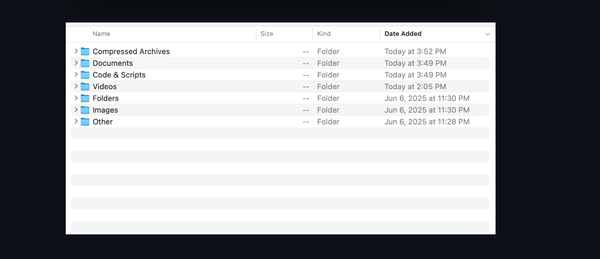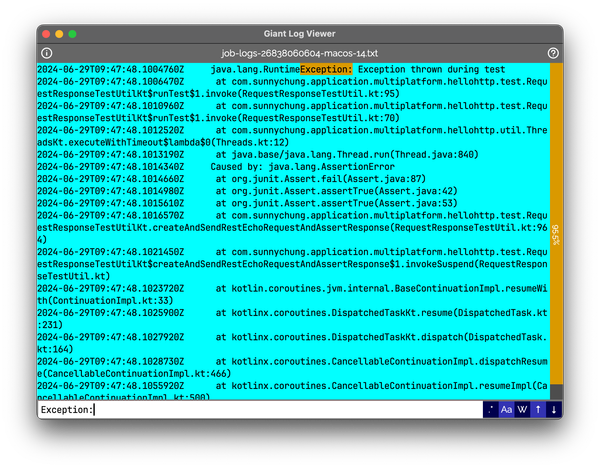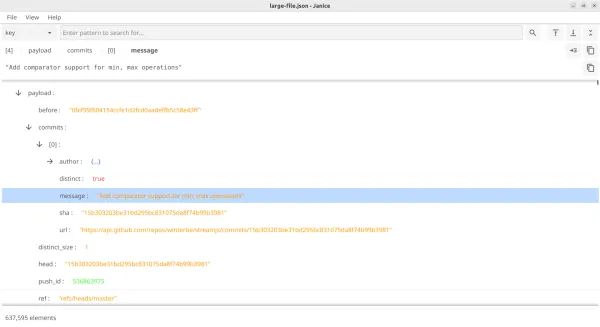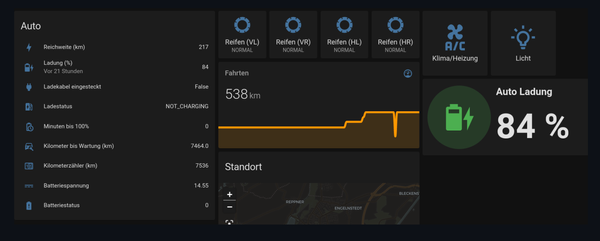30+ Large File Splitter Apps for Massive Text, JSON, CSV, PDF, and ICS Files
Table of Content
Let’s face it: we’ve all been there. You’re trying to import a massive CSV into Excel, upload a gigantic SQL dump to GitHub, or move a multi-gigabyte log file across systems, and your software just gives up. "File too large." "Out of memory." "Upload failed." Sound familiar?
Tired of Giant Files Crashing Your Apps? Meet the Ultimate Large File Splitter Toolkit
Welcome to the world of big data bottlenecks, and the real heroes: large file splitter tools.
Whether you're dealing with CSV, JSON, SQL, ICS, PDF, or plain text files, splitting them into smaller, manageable chunks isn’t just a convenience, it’s a necessity.
And in this post, we’re diving into the best free and open-source file splitters that can save your workflow, boost performance, and keep your sanity intact.

Why You Need a File Splitter (And When to Use One)
Large files are everywhere: database exports, calendar backups, server logs, data science datasets, and even game files. But most tools have limits.

Excel caps at 1 million rows. GitHub rejects files over 100MB. Google Calendar chokes on ICS files over 500KB. That’s where file splitter utilities come in.
Here’s when you really need one:
- Moving files via USB or shared drives?
FAT32 has a 4GB file size limit. Split large PS3 game files or videos into smaller parts with tools like SimpleSplitPS3 or Splich. - Uploading to GitHub or GitLab?
Beat the 100MB limit. Use Text-Splitter or File Splitter And Merger to split logs, CSVs, or config files, then reassemble them on the other end. - Debugging a 10GB SQL dump?
Open it in Notepad? Forget it. Use SQLSplit or SQL Dump Splitter to break it into one file per table—perfect for version control and team collaboration. - Importing a decade of calendar events?
Google won’t take your 2GB ICS file. Tools like ics_splitter.py or visualharmony/ics-splitter split it by year or size, so you can import events in batches. - Processing huge JSON datasets?
Streaming? Parallel jobs? Use split-json (Node.js) or json-splitter (Python) to divide large JSON arrays into smaller, processable files. - Working with logs or FASTQ files?
Need to split by line count for parallel analysis? Slicer and CSV File Splitter let you split by rows, preserving headers so each chunk is self-contained.
What’s in This List?
We’ve curated 30+ powerful, free tools built for real-world use:
- C#, Java, Python, Go, Bash, and Node.js, just pick your flavor.
- Cross-platform support: Windows, Linux, macOS.
- GUI and CLI options, from drag-and-drop apps like QtLargeFileSplitMerge to command-line power tools like BTXS™.
- Encryption, compression, merging, and auto-cleanup, some go beyond basic splitting.
Whether you need to split by size, line count, table, or event, there’s a tool here that fits.
Split Smart, Work Faster
You don’t have to fight with bloated files anymore. With the right large file splitter, you can:
- Bypass upload limits
- Speed up data processing
- Improve app compatibility
- Share files easily
- Debug and edit like a pro
So stop letting big files slow you down. Split them. Manage them. Own them.
👉 Explore the tools above, many are open-source, lightweight, and ready to run. Your next giant file doesn’t stand a chance.
1- Large Filter Splitter Tool:
This free lightweight C# app splits large text files like CSV, TXT, and LOG into smaller chunks, preserving headers, running fast, and supporting command-line automation, ideal for handling big data on Windows.

2- Splich (Split-Stitch)
Splich is a simple file splitting tool written in Python that can split a file into parts, and stitch them back together.
Its features include:
- Split into specific number of parts
- Split into parts of specific size
- Automatically finds the split parts in the directory
- SHA256 hash verification included
3- File Splitter Tool
This open-source app enables you to split files by size or number of lines.
With it you can splits large files into smaller parts using shared core code. Each split file keeps the original extension, with part numbers formatted as "_XX(YY)" (e.g., console_01(3).log), customizable via parameter. Both versions operate independently.
4- Slicer
Slicer is a free tool that enables anyone to slice a text file to smaller files by lines, with gzip compression for input/ output supported.
This tool can be used to slice big FASTQ files to smaller ones for parallel processing.
5- File-Splitter (Recommended)
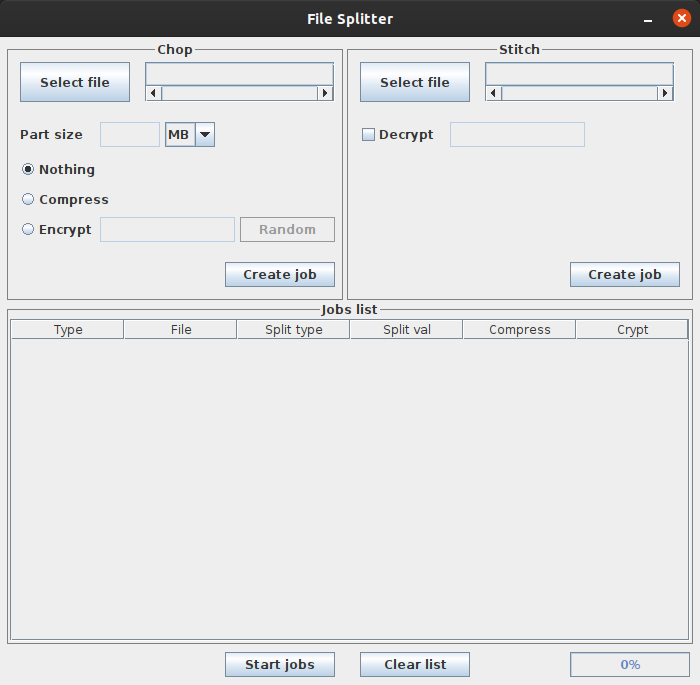
File-Splitter is a lightweight, cross-platform Java 8 application that lets you split, compress, and encrypt files securely. It supports splitting by size, ZIP compression, AES-128 encryption with a 16-digit password, and includes a built-in password generator. Designed for Windows and Linux, it allows queuing multiple files and automatically cleans up temporary files after processing.
Features
- Split by Size: Divide large files into smaller parts based on custom size limits
- ZIP Compression: Compress files into .zip format to save space
- AES-128 Encryption: Secure your files with strong encryption (16-digit password required)
- Password Generator: Built-in tool to create secure 16-digit encryption keys
- Batch Processing: Add multiple files to a queue and process them together
- Cross-Platform: Runs on Windows, Linux, and macOS (any OS with Java VM)
- Portable: No installation needed; run directly from the .jar file
- Auto Cleanup: Temporary files are deleted automatically after processing
- Smart Output Paths:
- Saves output in the app’s folder on Windows
- Saves output in the user’s home folder on Linux
- Easy to Use: Simple interface built with Java Swing, no complex setup
6- BTXS™ File Splitter
BTXS™ is a professional command-line tool for splitting large files into smaller, more manageable chunks and merging them back together.
It's built from the ground up to be reliable and provide a polished user experience, ensuring your data is never corrupted during the process.
7- QtLargeFileSplitMerge
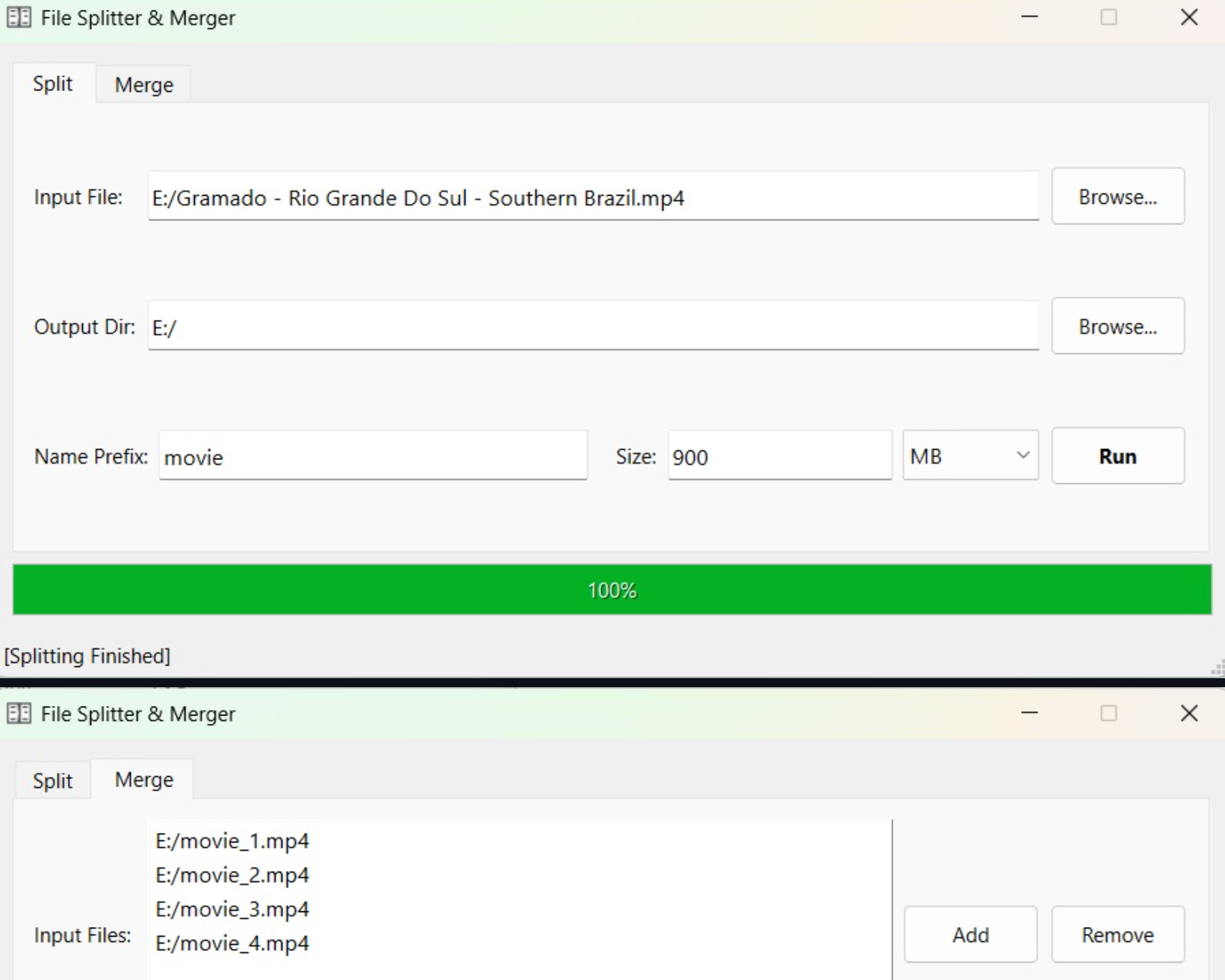
This is a Qt-based application designed for splitting large files into smaller chunks and merging multiple files into one. The application provides an intuitive graphical interface for users to easily manage file splitting and merging tasks.
The app features include:
- File Splitting: Split large files into smaller chunks based on user-defined chunk sizes.
- File Merging: Merge multiple files into a single file in the order specified by the user.
- Progress Tracking: Real-time progress updates during file operations.
- Multi-file Selection: Supports adding multiple files for merging.
- Customizable Output: Allows users to specify output directory, file naming patterns, and output file paths.
8- File-Splitter App (Windows)
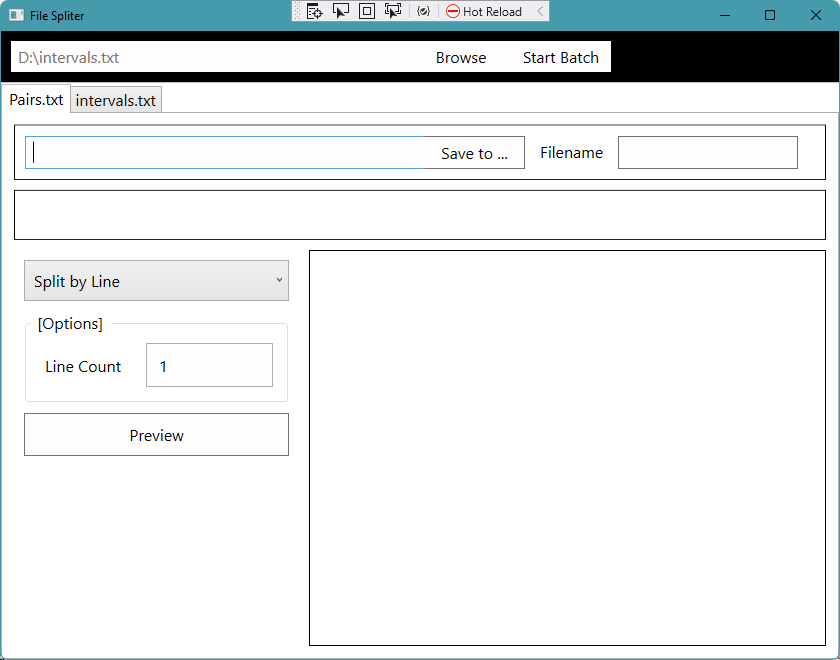
File Splitter is a powerful, user-friendly Windows desktop application built on the .NET Framework that helps you break down large files into manageable pieces using multiple splitting methods. Whether you're dealing with massive log files, CSVs, or text documents, this WPF-based tool gives you precise control over how your data is divided.
Features
- Multiple Splitting Modes: Split files by:
- Number of lines
- File size (KB, MB)
- Number of characters
- Specific text or phrase (e.g., split at every occurrence of "END_RECORD")
- Batch Processing: Process multiple files at once, each with its own settings and output configuration.
- Per-File Customization: Each selected file opens in its own tab, allowing you to apply different splitting rules, output paths, and naming schemes independently.
- Live Preview: Click Preview to see exactly how many output files will be created and what they’ll be named before running the operation.
- Flexible Output Settings
- Set custom output directory
- Define output file naming pattern
- Retains original file extensions unless specified otherwise
- No Installation Required: Portable executable, run directly from the folder. Ideal for USB tools or enterprise environments.
- Built for Windows: Native WPF application with clean UI, smooth performance, and full integration with Windows file system.
9- File Splitter
File Splitter is a C++ utility that allows you to divide a large file into multiple pieces of a size specified by the user. This feature is particularly useful when you need to transfer large files via limited storage media or when downloading large files over unstable networks.
Features
- Split by Custom Size: Divide large files into smaller chunks based on user-defined size (in MB)
- Binary Mode Processing: Ensures accurate byte-level handling for all file types (text, video, zip, etc.)
- Chunked File Naming – Output files named automatically as
filename.part1,filename.part2, etc. - Efficient Memory Usage: Uses fixed-size buffers to minimize RAM usage; ideal for very large files
- Safe File Check: Verifies input file existence before processing to prevent errors
- Batch Output Tracking: Stores and displays all generated chunk filenames upon completion
- User-Friendly Interface: Simple console prompts guide users through file selection and size input
- Crash Resistant: Prevents memory overload by processing files in manageable chunks
- Portable & Lightweight: Standalone C++ application with no external dependencies
- Ideal for Transfer: Perfect for splitting files for USB, email, or unstable network transfers
10- Python File Splitter
This is a Python Utility that can split a large file into smaller files. The files are split on lines that match a delimiter. The destination file path and a destination file name is expected in lines that follow each delimiter.
11- File Reader & File Writer (Large TEXT File Splitter)
FileReader and FileWriter are character based, they are intended for reading and writing text.
12- Text-Splitter (Python)
This Python script allows you to split a text file (.txt, .log, ..) in N partitions. A useful way to take advantage of this script is to overtake the 100MB GitHub limit, in this way you can create a folder with all logs/text files splitted on github without the Large File GitHub limit.
13- Text File Splitter
This is a simple program to split large text files into smaller ones. You can choose the amount of lines that each split file will have and also provide two files containing lines that will be added in the head and foot of each split file(I've called it prefix and suffix files for some reason).
14- File Splitter And Merger
File Splitter And Merger is yet another Python tool that helps you easily split and merge large files to meet GitHub's size limits.
It is built using the filesplit library, it automatically breaks down files over a specified size (default 100MB) and reassembles them when needed.
You can run with --split, --merge, or --list, and exclude files using the excluded_files list. Simple, fast, and perfect for sharing big files on Git.
15- Yet Another Splitter
Yet Another Splitter (YAS) is a tool designed to prepare large datasets—like VMDK images, disk images, or massive codebases—for binary scanning when file size exceeds scan limits (e.g., 5 GB). It enables scanning by splitting oversized files into smaller, processable chunks.
Before scanning:
- Data must be mounted as a filesystem
- Files larger than the scan limit are excluded unless unpacked
- Archives should be extracted and original archives removed
- A temporary storage location with sufficient space is required
Once prepped, set the environment variables and run the scan. YAS helps overcome scanning restrictions by making huge files manageable.
16- File Splitter (Go)
Filer Splitter is a small Go utility application for splitting a large file (think gigabytes) into smaller ones.
17- File splitter and joiner
File Splitter and Joiner is a lightweight tool designed to split large files into smaller chunks or join them back together, making it easy to transfer files through storage-limited shared folders.
It supports two main operations:
- Split: Break a large file into smaller parts of a specified size (e.g., 100MB, 1GB) using the
-sand-szoptions. - Join: Reassemble split parts into the original file using the
-joption by pointing to the first chunk.
Sizes can be specified in KB, MB, GB, or bytes. Ideal for moving big files across systems with space constraints.
18- File Splitter and Joiner
File Splitter and Joiner helps transfer large files through space-limited shared folders by splitting them into smaller, manageable pieces of a user-defined size, then rejoining them on the destination system to restore the original file.
SQL Dump File Splitter
1- SQL Dump Splitter
The SQL Dump Splitter is a Python tool designed to split large SQL dump files into smaller files based on specific conditions such as 'DROP TABLE' and 'CREATE TABLE IF NOT EXISTS'.
This tool is useful for managing large SQL databases where dumps can be excessively large for efficient handling.
2- Large SQL File Splitter Script
The SQL File Splitter Script processes large SQL files by extracting and categorizing SQL commands (like SELECT, INSERT, UPDATE) into separate files, counting their occurrences. It helps database administrators and developers analyze, debug, or migrate complex SQL dumps more efficiently by breaking them into manageable, type-specific files.
You might need it when dealing with massive SQL backups or scripts that are too unwieldy to edit or review as a single file. Built with Python 3.x, it’s easy to customize and run.
3- SQLSplit
SQLSplit is a utility that splits large SQL files into smaller ones, each containing the script for a single database table, making them easier to manage and edit. It also supports recombining the split files back into one cohesive SQL file. Ideal for version control, team collaboration, and simplifying large database dumps.
Features
- Split a large SQL file that contains multiple
CREATE TABLEstatements into separate SQL files, one for each table. - Optionally capture and include SQL header lines in each output file.
- Recombine the smaller SQL files back into a single SQL file.
- Display the progress of the file processing in the terminal.
- Command line interface for easy usage.
Split Large CSV Files
1- Large-CSV-File-Splitter
This is just simple Bash script to deal with large CSV Files. It automatically splits large .csv file into smaller parts preserving the header ( first line data ).
It uses the advantage of built in Linux CLI command "split".
By default it creates multiple files from one large .csv file with each of files containing maximum of 5000 ( five thousand ) records. You could modify this value as you like.
2- CSV File Splitter
A Python script to split large CSV files into smaller files with a specified number of rows. This tool is useful for managing large datasets and breaking them into more manageable pieces.
Features
- Handles filenames with or without
.csvextension: Automatically appends.csvif missing. - Customizable row limit: Specify the number of rows per split file.
- Header inclusion: Ensures headers are included in all split files.
- Dynamic output naming: Output files are named with the original row number range they contain, making it easy to track the data.
3- CSV splitter
A simple Python script to split big csv files (or any text files) into smaller ones.
4- Split CSV
A simple CSV file splitter written in BASH. It takes a big CSV as source and splits out multiple files of defined line count.
5- CSV Splitter Utility
The CSV Splitter Utility (splitcsv) is a lightweight command-line tool that splits large CSV files into smaller ones, each containing a user-defined number of rows. Headers are preserved in every output file, ensuring each can be used independently.
Split files are named with the original filename followed by -N (e.g., data-1.csv), and paths are printed to standard output. The tool uses consistent CSV formatting—fields in double quotes and escaped quotes doubled. If the file has fewer rows than specified, no split occurs.
Large JSON Files
1- Split JSON (JavaScript)
A small Node.js module that splits large JSON files (with an array of objects) into smaller part files.
It does the following:
- Opens a read stream to the large JSON file
- Reads each top-level item from the array, one at a time
- Writes each smaller list of items into a part file with sequencial numbering
2- json-splitter
A simple command line tool for splitting large JSON files into smaller files. Python 3+ is required for this script to work.
Split a Large ICS Files
An ICS file (short for iCalendar File) is a standard file format used to store calendar data such as events, meetings, appointments, and reminders. It is commonly used by calendar applications like Google Calendar, Outlook, Apple Calendar, and Thunderbird to import, export, and share scheduling information.
The file typically contains one or more calendar entries in a structured text format based on the iCalendar standard (RFC 5545).
You might need to split an ICS file when dealing with large calendar exports. Some apps like Outlook or web calendars have size or event limits, making it hard to import big files, splitting them ensures smooth imports.
If you have thousands of events, breaking the file into smaller chunks (like by year or month) makes them easier to manage, review, or archive.
It’s also helpful for sharing only part of your calendar, say, work events without personal ones. Smaller files are safer to back up and restore, reducing the risk of corruption.
During system migrations, splitting avoids timeouts or crashes caused by processing huge files. And since large ICS files can freeze text editors, splitting them makes it easier to inspect, edit, or fix errors. In short, splitting improves compatibility, performance, and control over your calendar data.
1- ICS Calendar File Splitter
A streamlined solution for migrating large calendar files to New Outlook (M365).
Features included:
- Handles decades of calendar data
- Preserves all calendar entry details
- Zero manual file splitting required
- Compatible with New Outlook's import requirements
2- Split ICS files
ICS files are great for moving calendar events between systems like Google Calendar and Microsoft Exchange. But here’s the problem: they can get huge, and most cloud calendars struggle with large uploads. Google, for example, has a very low limit (around 500 KB), which often blocks big imports.
Large PDF File Splitter
1- PDF File Splitter
This Python script allows users to split PDF files into smaller parts based on a size limit. It's particularly useful for handling large PDF files that need to be divided into smaller, more manageable files.
2- PDF Splitter
The PDF Splitter is a desktop application built in Java for splitting PDF files by size, by pages, and extracting email addresses from PDF documents. This project utilizes the PDFBox and iTextPDF libraries to perform these operations effectively.
Its features include:
- Split PDFs by size: Break large PDF files into smaller chunks of a specified size.
- Split PDFs by pages: Divide a PDF into multiple parts after a given number of pages.
- Extract email addresses: Retrieve and save all email addresses found in a PDF document to a
.txtfile.
PS3 Files
PS3 Large Game Files
SimpleSplitPS3 (formerly MiniSplit)
SimpleSplitPS3 is a tool for splitting large PS3 game files ( > 4294967295 bytes ) into .666## files so you can transfer them to a FAT32 formatted device (e.g. an external hard drive).
It can also join .666## files back into their original file.
Features
- Split large files into 4294967295 byte pieces (the max file size for FAT32).
- Join .666## files back into their original file.
- Delete source files after splitting or joining files.
- Rename game folders by adding an _ to the game folder once large files have been split or removing an _ from the game folder if split files have been joined.
- Change the destination directory. Useful if you want to keep the split/joined files separate from the source files or if you want to speed up the splitting/joining process by reading the source files from one storage device and writing the resulting files to another storage device.
- Recreate the folder structure of the source folder inside your chosen destination folder. Only applies when you've checked the Change checkbox. Lets you easily see where the newly split/joined files are supposed to go in the original game folder.
- Display per file and total progress with progress bars.
- Split/Join files from multiple game folders at one time.





